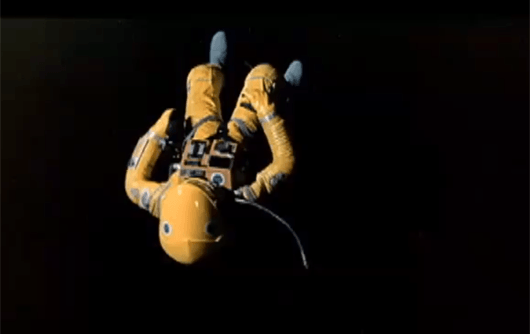When watching a science fiction flick, it can be hard to determine what time in the future it is set, although this is a usually an integral part of the movie. However, it is often obvious in which year the movie was made. The combination of costumes, cinematography, CGI, and content create an overall feeling that immediately makes you aware of when it was made. The celebrity actors are a dead give-away as well. Even the CGI capabilities of this post-Avatar-era are not enough to fool us- compare Jeff Bridges in Tron and Tron: Legacy.
The future depicted in these films always seems to follow the present in a linear fashion, while the actual future turns out to be wild, chaotic and unpredictable. Instead of an overview of correct predictions, the legacy of science fiction movies represents an interesting insight in the thoughts of people throughout the years. How the moon is depicted can be particularly telling of a given era's mindset. In Le Voyage dan la Lune, for example, the moon is shown as having a lush Earth-like ecosystem that makes for a grand adventure. In Duncan Jones' Moon, the moon has become much more like a true wilderness, isolated and uncaring.
It makes me wonder how will the moon be presented in science fiction movies over the next decade. Will it be overrun with nanotechnology, restored to a next natural landscape, or be another base for Jeff Bridges?
Below are some examples about traveling to the moon, from different eras. What time is the setting? Hard to determine. What year is it made? Much easier.
Georges Melies - Le Voyage dan la Lune (1902)
Stanley Kubrick - 2001: A Space Odyssey (1968)
Duncan Jones - Moon (2009)

natinja
A trip to the moon is easily accessible to any goal-oriented 19th century style bureaucracy with a bit of Newton physics. Melies’s movie is a perfect illustration of that spirit. It took NASA one hundred years to fix the details. Next came the have-nuclear-engine-will-travel spirit: submarines, battleships, cruise ships, airplanes, satellites, spaceships were deemed to be powered by nuclear reactors. It didn’t last long though, carbon-based life forms always spoil the fun. Kubrik’s picture runs in slow motion until it ends-up in the cathodic tube for a trip in the innards of the neurotic Cyclopes. Matter: 0. Light: 1. The next next thing, the inner-trip. Stuck in the cathodic tube, the mass discovers that there is much more space inside than outside. Unfortunately, there are some side-effects: past, present and future all happen at once. But no problem, computers are the new historians and keep tracks. Human to computer: I think we have lost track of time. Computer to human: man lost it, I never miss a tick. The mystic experience of already having been Terre* is now widely experienced through video games. Earth will eclipse the moon as the new destination, literally (cf. Another Earth, a motion picture to be released this Summer) * Earth in French
Posted on